Lamb's Quarters-1
Chenopodium album "goose foot" is almost everywhere
Lamb’s quarters, the edible weed with many names, stays good after the heat takes out many of the leafy vegetables, so it’s important to leave some space for it. You can offer this mild flavored plant to those who complain that the brassica weeds (wild mustards) are too bitter. It’s great raw or cooked. Consider it a good introductory weed for new foragers. The leaves and the seeds are useful, and you can chew up some stems too, if you pick very young plants. Plants between 1 and 2 meters still have palatable leaves to offer, particularly at the tips. Like amaranth, the seeds can be collected as a grain. This practice continues agriculturally in various parts of the world, though it’s a lot of work. This arduous process could mitigate the health problems we have as a result of food being too readily available.
The origins of Chenopodium album are obscured by its extremely wide distribution globally. As an important nutritional and medicinal plant as well as noxious weed, it has hundreds of common names. It’s both a forage food and worrisome for livestock which might consume too much of the nitrates, phytates and oxalates that are more concentrated in the stems. Sticking to leaves, flowers and seeds, as well as cooking, reduces this problem for humans. Oxalate bioavailability from this weed is reduced by the high amount of calcium it contains, so that it’s less of a health issue than with some of the veggies that we regularly see at a grocery store.
Medicinally this plant is credited with myriad activities including sedative, topical pain relief, anti-pruritic (anti-itch), liver protectant, treatment of dental caries, sexual performance enhancer, sperm immobilizer, diuretic, antiscorbutic (counteracts scurvy), antihelmintic, and antispasmodic.
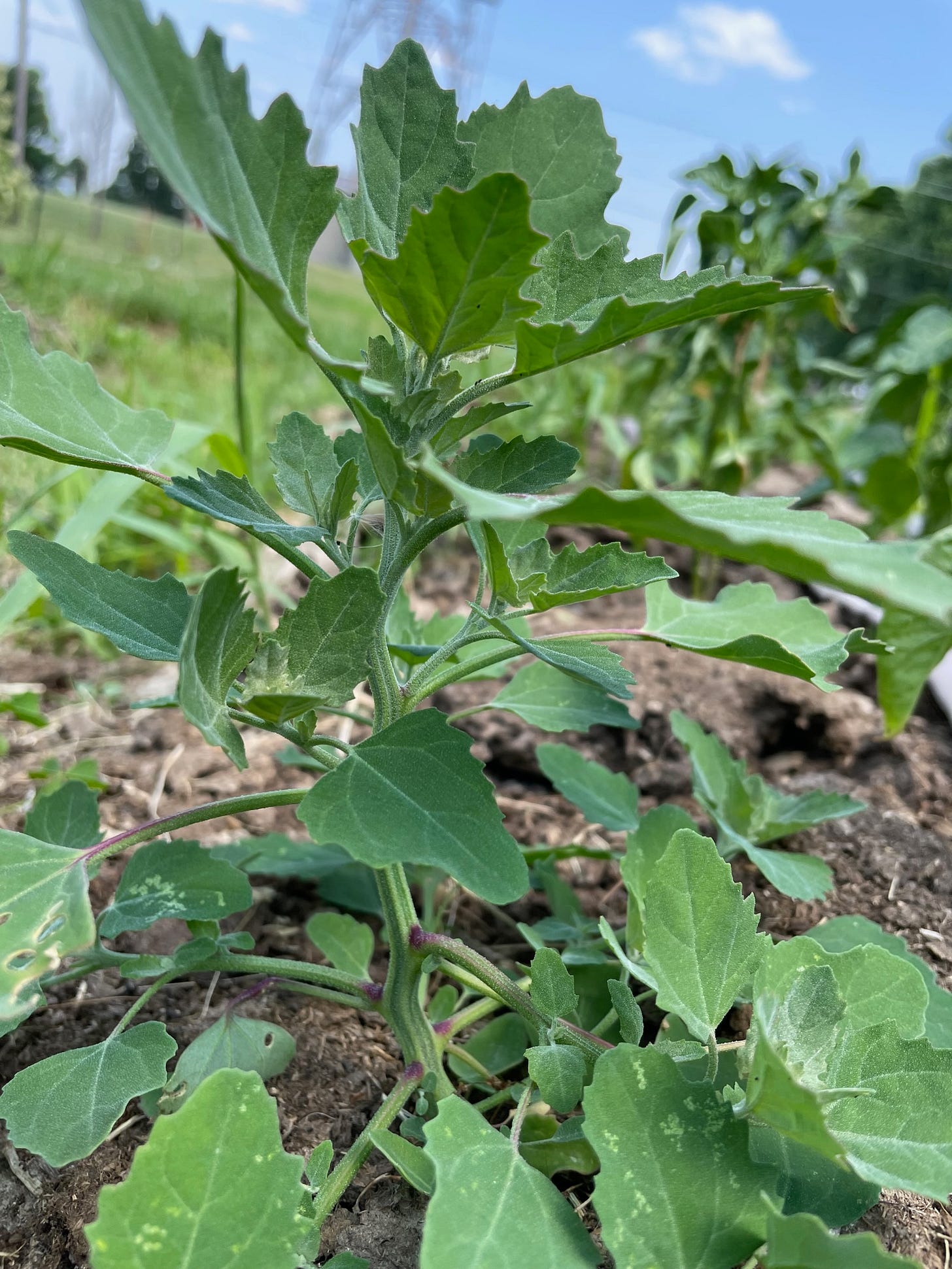
It’s time to learn how to find this weed!
The Botanical lumpers place Chenopodium in the Amaranthaceae, buckwheat family, and the splitters gave it its own family, Chenopodaceae. This weed is related to the Chenopodium quinoa plant, which is a significant food grain in South America. Nutritionally conscious people in the U.S. like the high protein content of this grain, a quality shared by the little seeds of lamb’s quarters. Other food and grain producing relatives are C. berlandieri, common in central U.S., C. hybridum, (or simplex) in the East, C. capitatum in the North, C. Fremontii in the West. All of them are edible, and some have bigger seeds which are easier to collect. The more toxic Chenopodium species such as ambrosioides (wormseed) are notably more aromatic, so ‘you can tell by the smell’. Lamb’s quarters grows in hardiness zones 3a to 10b, and usually shows up in our region, (northernmost 6) in later spring after there is no danger of frost. It flowers in summer to fall. Collecting the seeds in October or later is “easier”, because you won’t have to separate out unripe ones. Plants reach from 1-2 meters (3-7 feet) in height, are branching, and more tall than wide. Stems have prominent ridges and show a dark magenta or purply color at the leaf axils, where new branches also emerge.
The leaves of lamb’s quarters vary quite a bit in shape. They can be long and narrow, or more palmate as shown by the undersides of the larger leaves in these pictures. The edges of the leaves are somewhat between lobed and serrate. The serrations are rounded and more symmetrical than such plants as poison ivy. The best way to know you’re looking at chenopodium album is to start at the top and feel the whitish mealy exudate from the hairs on the upper leaves. As the leaves grow, this becomes more sparse, but can still be felt on the undersides particularly, and they take on a smoother feel.
Look for pinkish, or faint peach colors at the tips of this plant. Some varieties put out bright magenta tips and stems, and you’ll see traces of this quality on most of them. These colors are produced by betalain alkaloids, which are water soluble compounds with anti-oxidant and anti-inflammatory properties. Good stuff!! Two types are the betacyanins (magenta), and the betaxanthines (yellow to orange). They can show up on the stems and the leaf petioles.
Our plants aren’t flowering yet, (mid June) which is good, because we want more little leaves. In fact, we’re still getting sprouts. We’ve had a lot of cool weather this spring, and they’re not being shaded out. So we’ll direct you here for a slide show, and here for some floral pics, because those can be eaten too, at the stage when they’re just budding. Some people use the buds for broccoli substitute. Flowers are tiny, a couple millimeters wide, with 5 anthers, 5 sepals and no petals. They occur at the tips in multi branched, elongated groups called panicles that can grow up to 8 inches long. Wind pollinates these plants with each one capable of producing thousands (up to 50,000) tiny seeds which are black or brown when fully ripe.
Chenopodium album leaves and seeds contain a good variety and balance of amino acids, including the essential 8 that humans don’t produce. Raw leaves contain over 4% and the seeds contain 13% protein. The mineral and vitamin profile of this plant is also excellent. Instead of filling up your screen with quoted data, we direct you to this extensive list, compiled at the USDA. One of the biggest advantages of this plant is that the leaves keep a long time in the refrigerator. Many other edible plants need to be used or cooked pretty fast. At weedom, we eat the leaves raw in salads or stir fried or boiled. Purslane and shepherd’s purse show up here at the same time, so they frequently go together in our cooking. During years of plenty, we’ve offered some of these weeds at farmer’s market since they’re tops in palatability, and hold up better than most in the heat. The leaves of lamb’s quarters don’t grow bitter. The main issue that might end harvesting is when they become too chewy. We cut off the petioles of the leaves and keep eating. If the mealy stuff on the youngest leaves is too weird for you, rub the leaves to wash it off, and/or use leaves that are a bit older. At normal human proportions, the raw leaves are fine, but keep in mind that cooking them, particularly boiling them, allows you to eat more. Boiling and steaming vastly reduces the oxalates, phytic acid and nitrates which concern many people. Our salad mix includes these raw leaves while they’re available. Our stir fried rice gets some of this too. Cook it to soften it a bit, so it works well in the spinach dip. Smoothie and pesto people can add this to their concoctions.
Lambs quarters has very mild activity against hookworms and roundworms, and in various cultures is considered beneficial as a digestive nutraceutical. Ascaridole, an unusual terpene peroxide compound is found in large quantity in a related plant, Chenopodium ambrosiodes, (American wormseed), from which a long used worm remedy had been derived and marketed. Like almost every other essential oil, this one had toxic liability due to inappropriate dosing and administration, and it lost out to the pharmaceutical manufacturers production of single ingredient anti-parasite drugs. Read some fascinating history here , (but watch out for pages out of order.) Ascaridole as with most anti-parasite meds, has dose dependent toxicity to humans as well as parasites, so knowing one’s limits is important. This constituent exists in much smaller quantity in lamb’s quarters. Cymene, a compound also found in cumin, thyme, coriander, and hemp, etc. is available in much larger quantity in our benign Chenopodium album, positively influencing both its odor and palatability. Cymene credited with all sorts of activity from antianxiety and anti-inflammatory to antimicrobial, and even anti-cancer. The 0.64% volatiles found by Usman and Hamid et al, in fresh Nigerian grown Chenopodium album leaves showed the presence of α-terpineol and β-pinene (6.2 % of each), α-pinene (7.0 %), pinane-2-ol (9.9 %), ascaridole (15.5 %), and p-cymene (40.9 %).
In addition to the essential oils and compounds mentioned above, lambsquarters is packed with flavonoids such as kaempferol and quercetin derivatives, various plant sterols, alkaloids, ecdysteroids, tannins. There are numerous tropanones to which significant liver protection (comparable to silymarin from milk thistle) has been credited, and saponins, the suds from which you’ll surely encounter if you harvest the seeds using water to separate them from the chaff. So you know that further coverage of our Chenopodium album is warranted during the colder months. So much more medicine remains to be covered. Meanwhile, find this plant and start your relationship with it. There’s plenty of it around, but when more people discover it, you’ll see a reason to make sure that it keeps coming back.
At Weedom, we thank our Creator for ensuring that we have an abundance of weeds to utilize, and write about. We thank you for reading.
Tell us what you think, and what weeds you’re finding! Though lots of people are reading, just a few are commenting here. When there’s some more action in comments and notes, we’ll know its time to fire up the chat, and start some interactive features so we can all show each other new stuff!
Where we dig
1. Lewis D. Wormseed: Carroll County’s Cash Crop Weed. Accessed June13, 2023 https://hsccmd.org/wp-content/uploads/2020/02/Winter-Journal-2018.pdf
2. Ma QG, Wei RR, Zhang XD, et al. Tropolone derivatives with hepatoprotective and antiproliferative activities from the aerial parts of Chenopodium album Linn. Fitoterapia. 2020;146:104733. doi:10.1016/j.fitote.2020.104733
3. Thayer S. The Forager’s Harvest - A Guide to Identifying, Harvesting, and Preparing Edible Wild Plants. Forager’s Harvest Press; 2006. https://openlibrary.org/books/OL8588402M/The_Forager's_Harvest
4. Al-Snafi A. The Chemical Constituents and Pharmacological Effects of Chenopodium Album - an Overview. International J of Pharmacological Screening Methods. 2015;5:10-17.
5. Madrigal-Santillán E, Madrigal-Bujaidar E, Álvarez-González I, et al. Review of natural products with hepatoprotective effects. World J Gastroenterol. 2014;20(40):14787-14804. doi:10.3748/wjg.v20.i40.14787
6. Lamb’s quarters – Chenopodium album. Published June 22, 2016. Accessed June 12, 2023. https://www.healthbenefitstimes.com/lambs-quarters/
7. Lamb’s Quarters: Pictures, Flowers, Leaves & Identification | Chenopodium album. Accessed June 11, 2023. https://www.ediblewildfood.com/lambs-quarters.aspx
8. Lamb’s Quarters - Chenopodium Album: Edible & Medicinal Uses of the Quinoa of Wild Plants - Song of the Woods. Published November 13, 2020. Accessed June 12, 2023. https://www.songofthewoods.com/lambs-quarters-chenopodium-album/
9. Ganora L. Herbal Constituents, 2nd Edition - Foundations of Phytochemistry. Lulu Press, Inc.; 2021. https://openlibrary.org/books/OL35083771M/Herbal_Constituents_2nd_Edition
10. Foraging Wild Quinoa (Goosefoot Seed). Practical Self Reliance. Published October 6, 2018. Accessed June 13, 2023. https://practicalselfreliance.com/chenopodium-album-grain/
11. FoodData Central. Accessed June 13, 2023. https://fdc.nal.usda.gov/fdc-app.html#/food-details/169244/nutrients
12. Common Lambsquarters | Cornell Weed Identification. Accessed June 11, 2023. https://blogs.cornell.edu/weedid/common-lambsquarters/
13. Poonia A, Upadhayay A. Chenopodium album Linn: review of nutritive value and biological properties. J Food Sci Technol. 2015;52(7):3977-3985. doi:10.1007/s13197-014-1553-x
14. Saini S, Saini KK. Chenopodium album Linn: An outlook on weed cum nutritional vegetable along with medicinal properties. ELSR. 2020;06(01):28-33. doi:10.31783/elsr.2020.612833
15. Chenopodium album Fat Hen, Lambsquarters PFAF Plant Database. Accessed June 12, 2023. https://pfaf.org/user/Plant.aspx?LatinName=Chenopodium+album
16. Hussain S, Asrar M, Rasul A, Sultana S, Saleem U. Chenopodium album extract ameliorates carbon tetrachloride induced hepatotoxicity in rat model. Saudi J Biol Sci. 2022;29(5):3408-3413. doi:10.1016/j.sjbs.2022.02.014
17. Chenopodium album | Purdue University Famine Foods. Accessed June 12, 2023. https://www.purdue.edu/hla/sites/famine-foods/famine_food/chenopodium-album-2/
18. Chenopodium album (PROTA) - PlantUse English. Accessed June 11, 2023. https://uses.plantnet-project.org/en/Chenopodium_album_(PROTA)#Chenopodium_murale
19. CABI. Chenopodium album (fat hen). CABI Compendium. 2021;CABI Compendium:12648. doi:10.1079/cabicompendium.12648
20. Chenopodium album (Baconweed, Bacon Weed, Fat Hen, Frost-blite, Goosefoot, Lambsquarters, Pigweed, White Goosefoot) | North Carolina Extension Gardener Plant Toolbox. Accessed June 12, 2023. https://plants.ces.ncsu.edu/plants/chenopodium-album/
21. Usman LA, Hamid AA, Muhammad NO, Olawore NO, Edewor TI, Saliu BK. Chemical constituents and anti-inflammatory activity of leaf essential oil of Nigerian grown Chenopodium album L. EXCLI J. 2010;9:181-186.
22. Helthyleaf. Bathua - Uses, Benefits, and Side Effects of Chenopodium Album. Helthy Leaf. Published January 27, 2023. Accessed June 12, 2023. https://helthyleaf.com/benefits-of-bathua/
23. Bhatia M, Singh S, Pagare S, Kumar B. A Pharmacological Comprehensive Review on Chenopodium Album L. International Journal of Current Research. 2021;12(12):15360-15368. doi:10.24941/ijcr.40425.12.2020



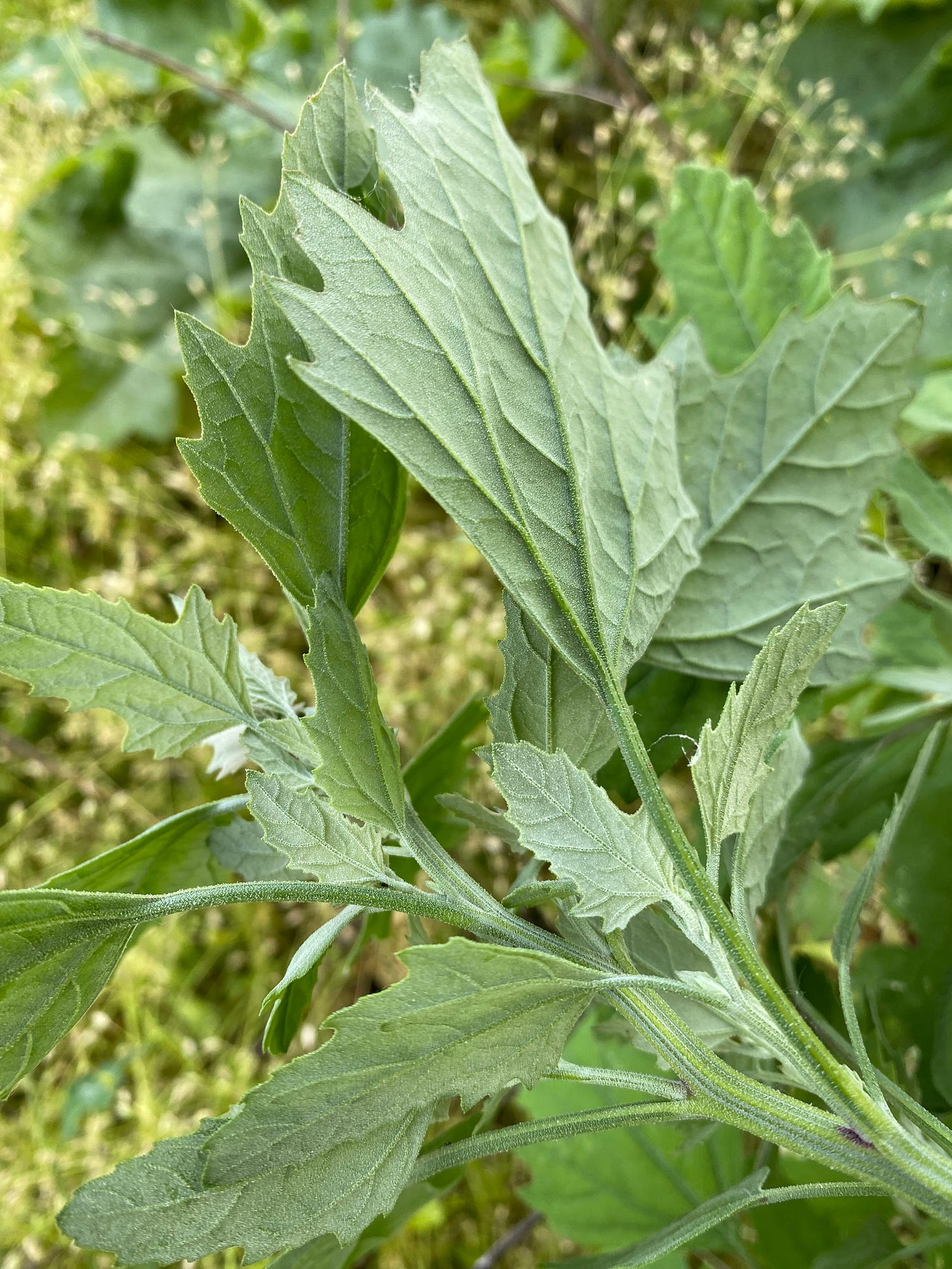
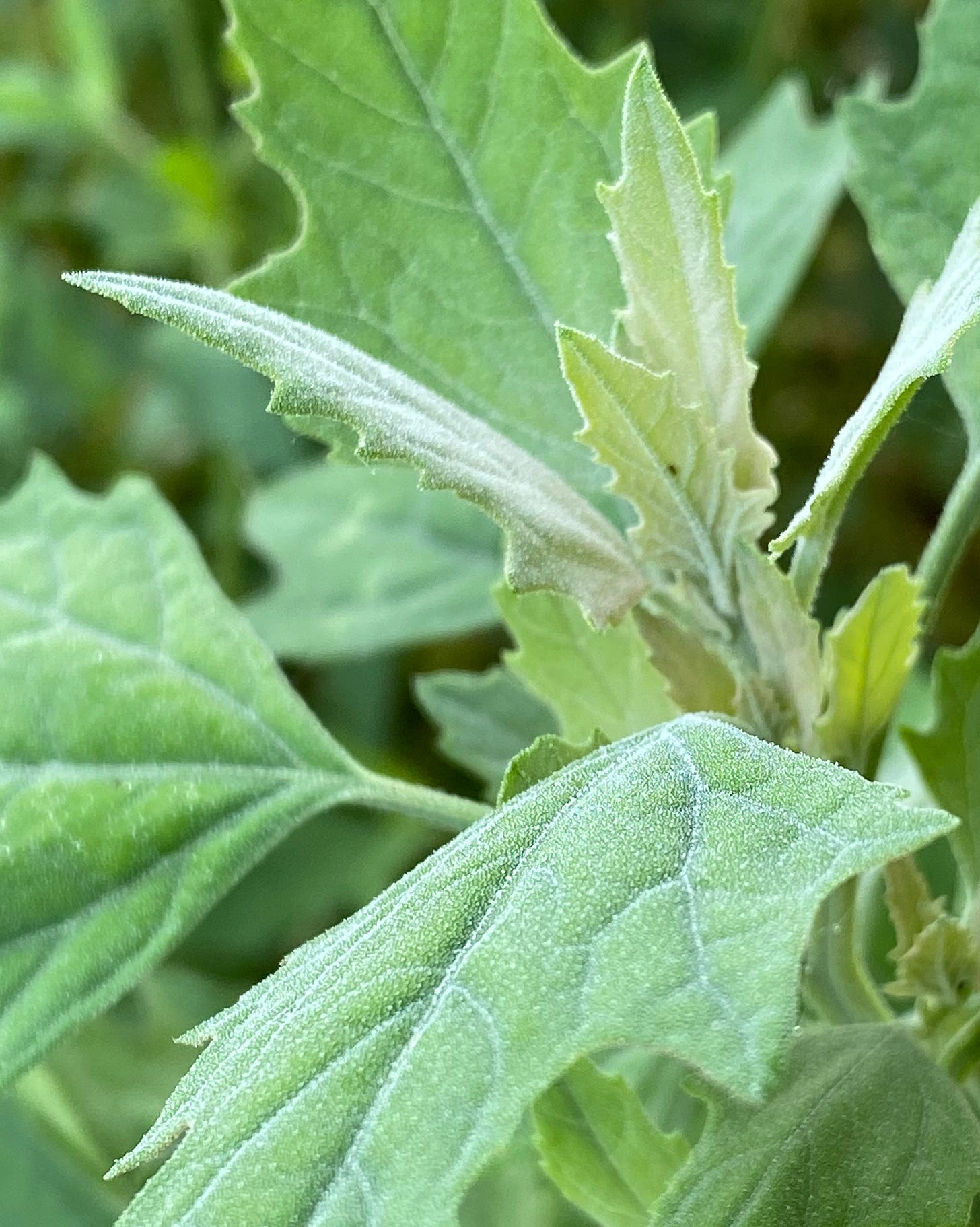
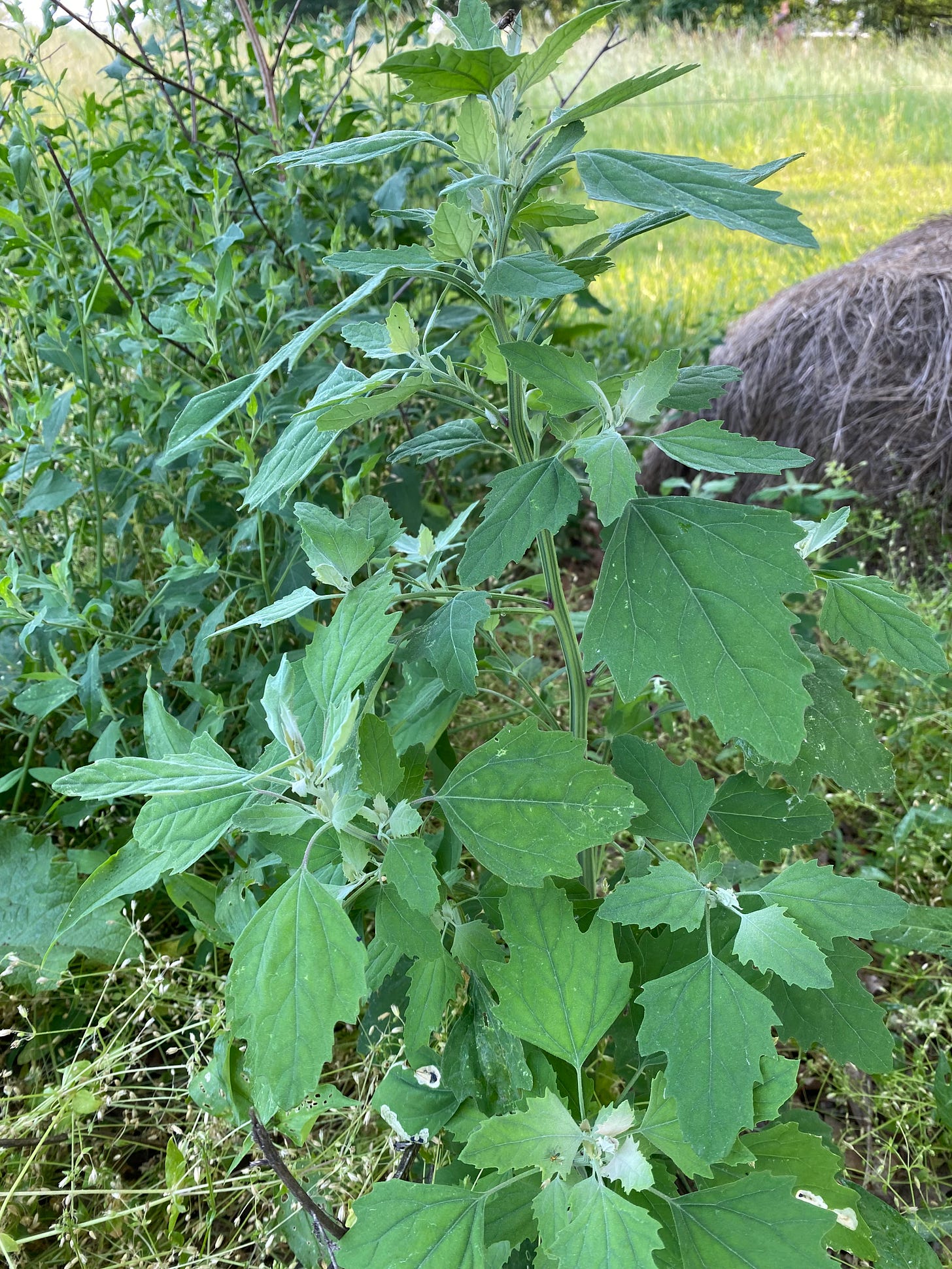
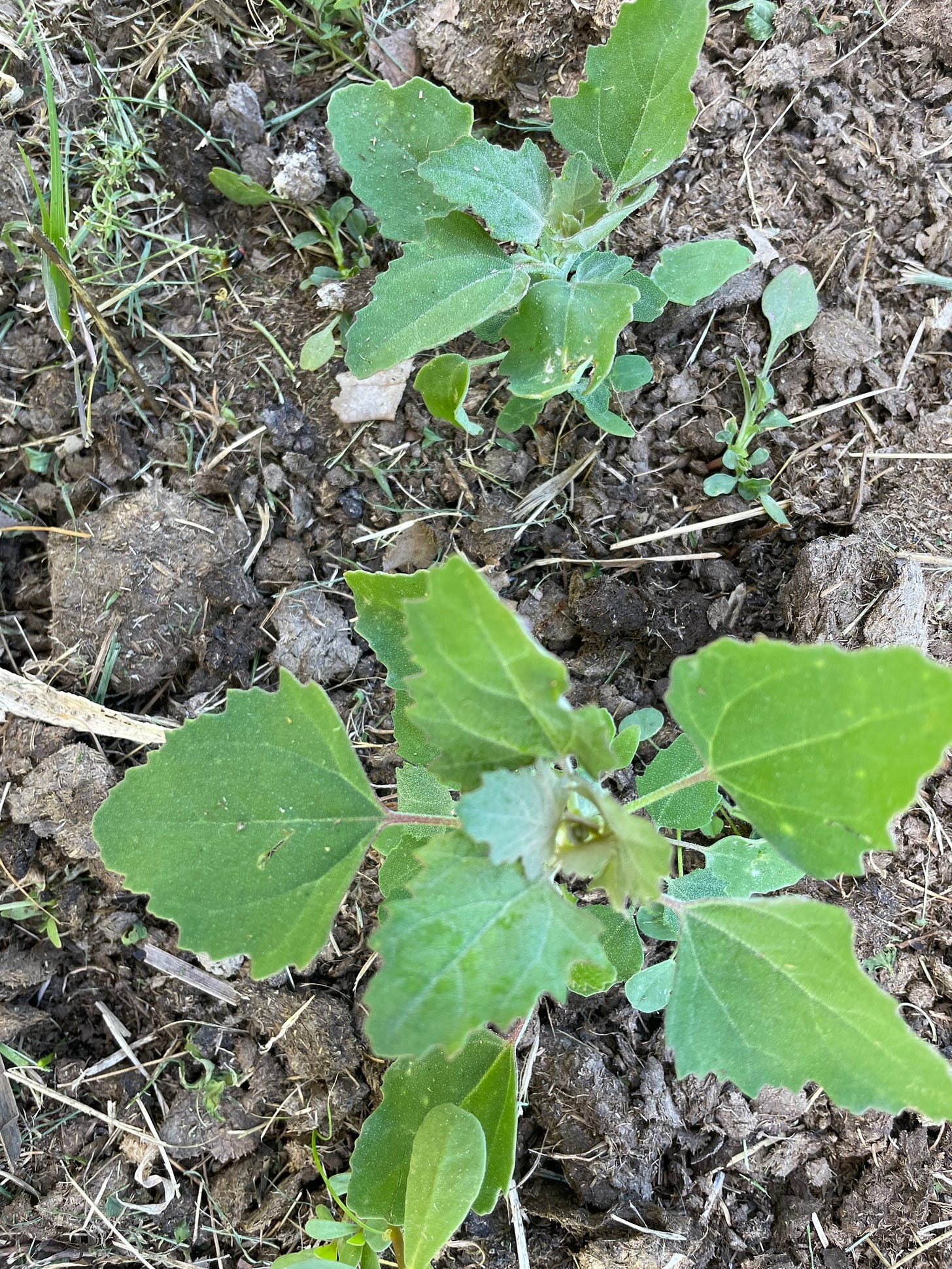
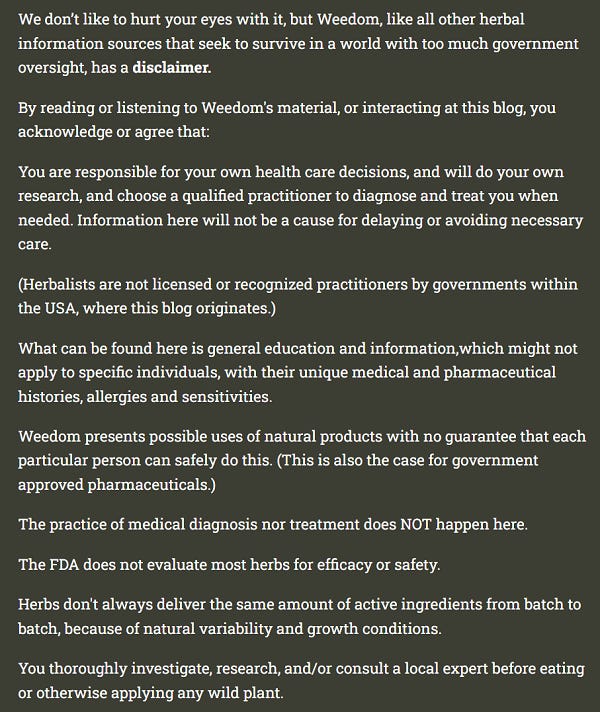
Thanks for the teachings. Very helpful and relevant info in todays uncertainty. Hope you don’t mind I’ve shared to Tumblr
Probably my favourite spinach substitute! A shame they're only available in the summer! Aussies can see some of our local Chenopodiums here:
https://bushfoodforager.substack.com/p/fat-hengoosefoot